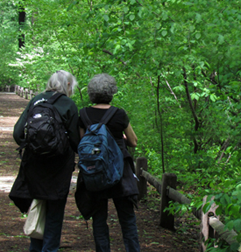There’s Strength in Numbers
Posted in Behind the Scenes, Science on September 15 2011, by Sandy Wolkenberg
Ed. note: Sandy Wolkenberg is a Citizen Scientist who has been working in the Thain Family Forest for three and a half years. Over the course of a week on Plant Talk, Sandy will share a five-part series of posts on The New York Botanical Garden’s Citizen Scientist Tree Phenology Program. If Sandy’s experiences motivate you to want to know more about becoming a Citizen Scientist, check out the Garden’s Volunteer Program page.
In the fall of 2008, at the beginning of the Citizen Science Tree Phenology program, the Volunteer Office encouraged those of us participating to find partners to work with. Because of my variable schedule at the Garden, I ended up walking the Spicebush Trail in the Thain Family Forest by myself. These walks often occurred in the early morning when intense sun glare or mist made identification of phenological phases difficult. In retrospect, although I treasured those quiet phenology walks, I had so little history with the program and so very many questions about what I was seeing, or hoped I was seeing, or imagined that I was seeing, that the prospect of walking with other volunteers was compelling. So it was a fortunate time when, in the spring of 2008, phenologists received the following email from Volunteer Services:
Dear Citizen Scientists:
Several people asked about finding partners, so let us walk through this issue. Although you don’t have to have a partner, we think that for many of you it might make learning the program easier and more fun. If you want a partner let us know your availability and we’ll do our best to match you up with someone with a similar schedule.

And that is how Sheila and I became partners. We fumbled our way into the spring, 2008, Forest Phenology walks, binoculars glued to our eyes when we weren’t looking at the booklet to see if we could actually be seeing what we thought we were seeing taking into consideration the time of year in which we were seeing it. Meher joined us after a Citizen Science Training session and we met Barbara wandering in the Forest looking for tree tags. It was her first time “phenologizing” and she quickly agreed to join us. Working together as a group has been an engaging, productive, and very satisfying experience. Each member brings a special talent or skill, and together we have grown in our ability to identify the different phenological phases for each tree.
And oh, the many adventures and memories we have shared together and the things we have learned! Did you know that trees flower and produce fruits? Here we look for blossoms on one of our favorite trees – the tulip poplar. Below are photographs for most of the tulip tree phenophases:
In Sandy’s next post, a 150-year old tree falls in the Forest.







